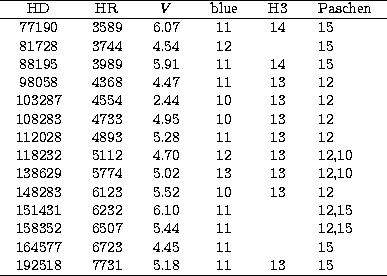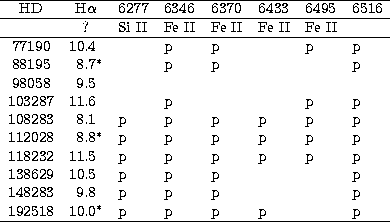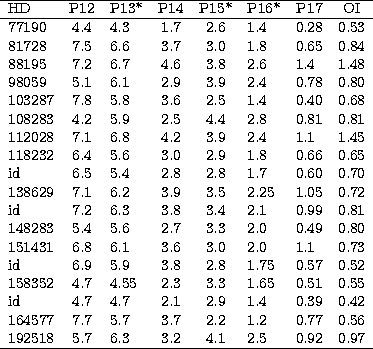 (11= April 11, 1996). |
 (11= April 11, 1996). |
Our intention was to observe these stars in three wavelength regions: in
the blue ![]() ,
the H alpha(=H3) region
,
the H alpha(=H3) region ![]() and the Paschen
region
and the Paschen
region ![]() , but due to cloudy nights
this coverage could not be
achieved for all stars. The stars were not observed simultaneously in the
different ranges, but in view of the slowness of the changes, time differences
of at most five days are probably unimportant. Several MK standards were
observed for each region (see Table 2). We did not observe standards for the
Paschen region, because these have
already been published in Andrillat et al. (1995).
, but due to cloudy nights
this coverage could not be
achieved for all stars. The stars were not observed simultaneously in the
different ranges, but in view of the slowness of the changes, time differences
of at most five days are probably unimportant. Several MK standards were
observed for each region (see Table 2). We did not observe standards for the
Paschen region, because these have
already been published in Andrillat et al. (1995).
We have measured the equivalent widths
with the computer program IHAP of
ESO. The precision of the equivalent widths
is of the order of ![]() for medium
and strong lines and somewhat less for the weaker lines. The equivalent widths
are given in Tables 3 and 4 for the red and infrared regions respectively. No
values were measured in the blue region, due to the large number of metallic
lines which produce many blends.
The lines
for medium
and strong lines and somewhat less for the weaker lines. The equivalent widths
are given in Tables 3 and 4 for the red and infrared regions respectively. No
values were measured in the blue region, due to the large number of metallic
lines which produce many blends.
The lines ![]() 6347(Si II M.2),
6371(Si II M.2), 6456(Fe II M.74), 6496(Ba
II M.2) and 6516(Fe II M.40) are absent in A0 V (except 6516) appear in A2 and
strenghten with advancing type toward late A. No difference in the behavior of
these lines seem to exist between the class III and V stars in this spectral
range.
6347(Si II M.2),
6371(Si II M.2), 6456(Fe II M.74), 6496(Ba
II M.2) and 6516(Fe II M.40) are absent in A0 V (except 6516) appear in A2 and
strenghten with advancing type toward late A. No difference in the behavior of
these lines seem to exist between the class III and V stars in this spectral
range.
 Equivalent widths given in A. p means visible, but not measured. |
 OI is blended with P 18. Equivalent widths given in A. |
Copyright The European Southern Observatory (ESO)